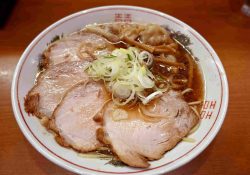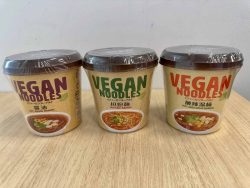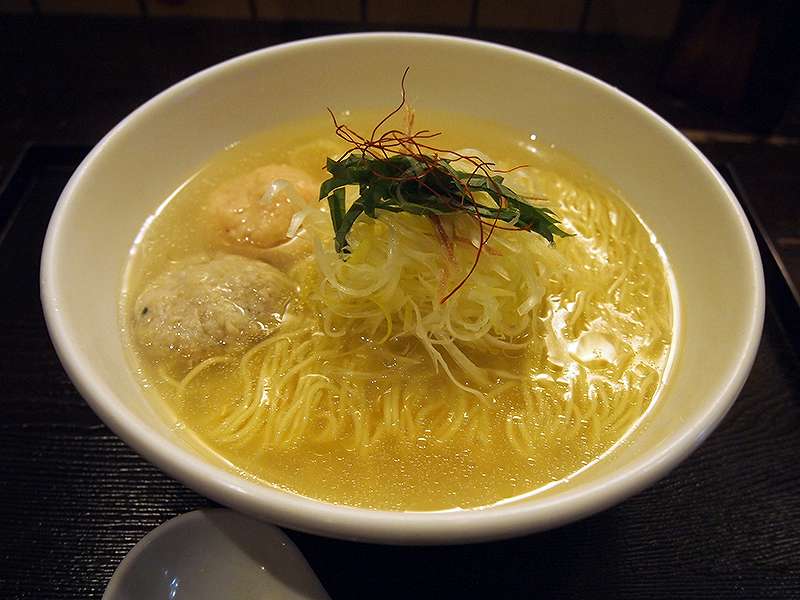
Salt ramen (¥800 excluding tax)
14:16 JST, November 16, 2020
At the small entrance atop a set of narrow stairs, I took in a painting of the sea on the wall with the word Kaijin written in masterful calligraphy on it. Kaijin means “sea god.”
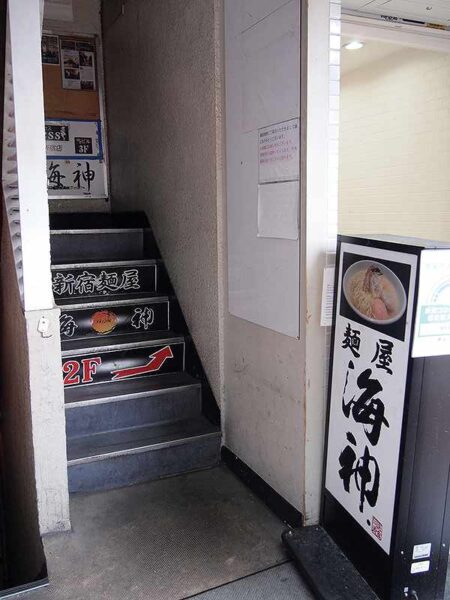
The narrow stairs to Kaijin and a sign
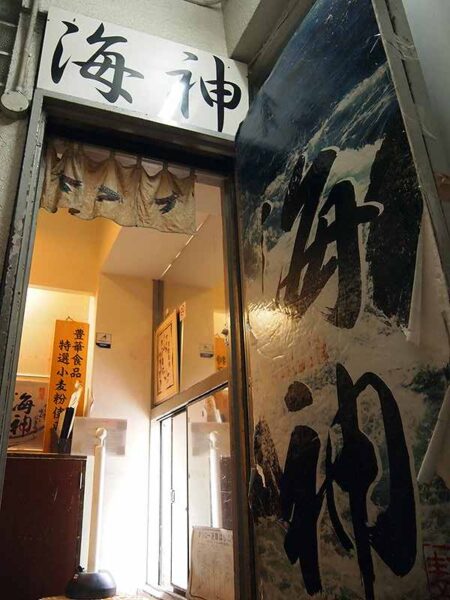
Outside of the entrance to Kaijin.
I went into the shop and was taken to the counter. There was a sign written in Japanese calligraphy in front of the counter reading “Honjitsu no ara (Today’s fish bony parts used in the soup)” — red sea bream, conger eel, salmon and hiramasa yellowtail amberjack. When I opened the menu on the table, there were only two types of ramen with ara broth — shio (salt) and karashio (spicy salt). Customers also have the option of including a heshiko yakionigiri, or grilled rice ball that is made with heshiko pickled mackereln with their order. I ordered a serving of the salt ramen and added the yakionigiri since I was hungry.
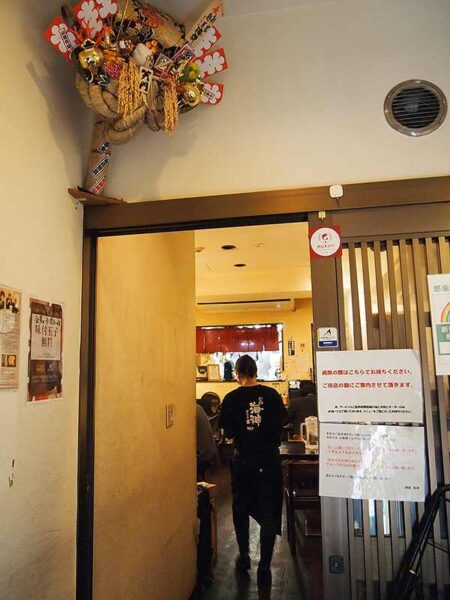
The entrance to Kaijin
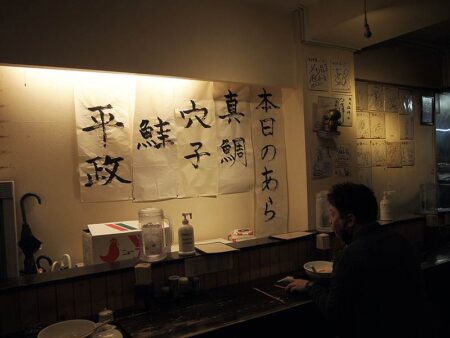
Counter seats
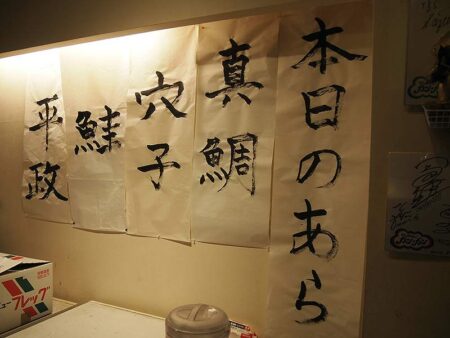
A menu on the counter
Even just before closing at 3:00 p.m., customers were still coming in later than I had, reaffirming the shop’s popularity.
Kaijin in Shinjuku is a ramen shop famous for its salt ramen noodles in a soup made from fish bony parts.
The restaurant makes its broth by boiling whatever fish leftovers they have that day. While I usually favor tonkotsu ramen, which is made from pork bones, I sometimes feel up for fish-soup ramen.
Kaijin can be found at the southeast exit of JR Shinjuku Station, with a signboard immediately visible after you leave the ticket gate. It’s on the second floor of a multi-tenant building.
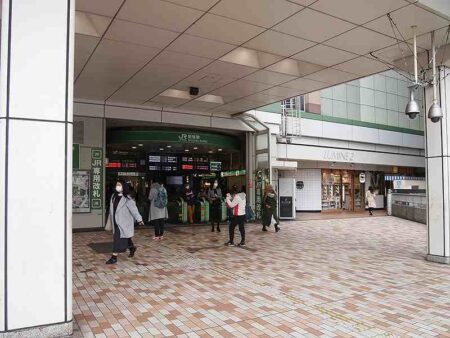
The southeast gate of JR Shinjuku Station
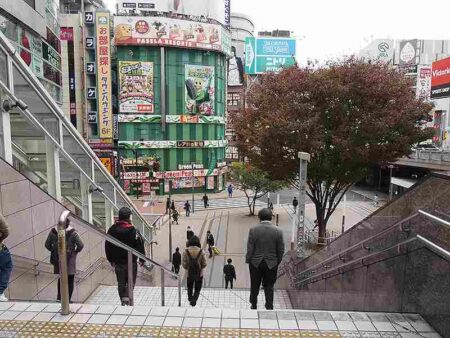
The view from the southeast gate of JR Shinjuku Station
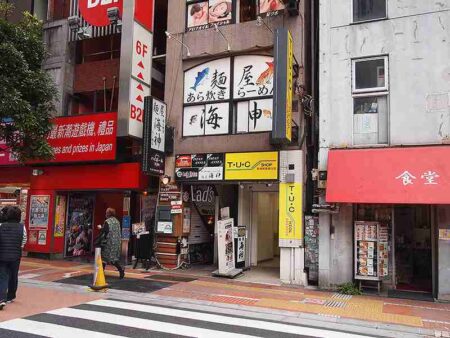
The exterior of Kaijin
The ramen I ordered came in a transparent broth. There was no chashu roasted pork, but instead, two kinds of fish meatballs to serve as toppings. The spices were in the middle of the bowl, along with Japanese leek, myoga Japanese ginger, ginger, shredded chili pepper and a green shiso leaf. Since myoga and shiso are my favorite condiments, it was a delightful treat for me.

Salt ramen with a heshiko yakionigiri (grilled rice ball)
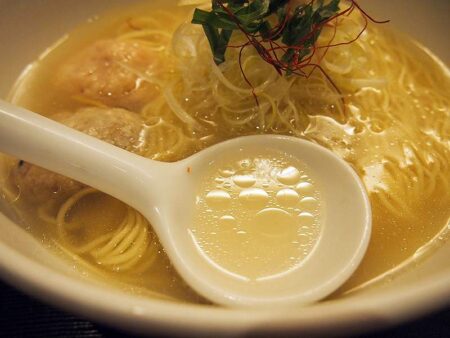
A spoonful of broth
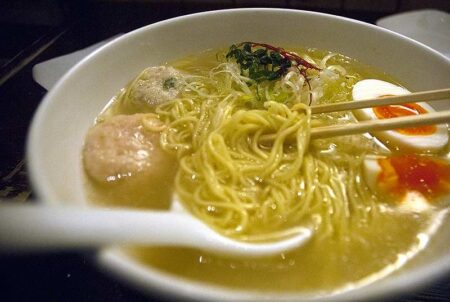
Noodles
I immediately tasted the broth, with its deepened scent of fish. It looks like a standard Japanese-style clear soup, but if you take a sip while believing it to be simplistic, you would be surprised by the strong richness of the fish aroma and taste. And yet, the broth doesn’t have a bad fish smell at all. I also slurped the noodles — thin noodles that bring out the gentle taste of the soup. I think it was all good for my stomach.
I took some of my favorite shiso pieces and ate them along with the noodles, the refreshing smell stimulating my appetite. Each condiment changes the taste and aroma of the ramen, which allowed me to enjoy changing the taste little by little. The pink fish ball was shrimp, and I ate the ramen while enjoying the unique texture of them.
The brown meatball is made from chicken. Sometimes the cartilage hit my teeth, but it was filling. The texture, taste and smell were different from those of the shrimp ball, helping me to continue eating the ramen without tiring of it.
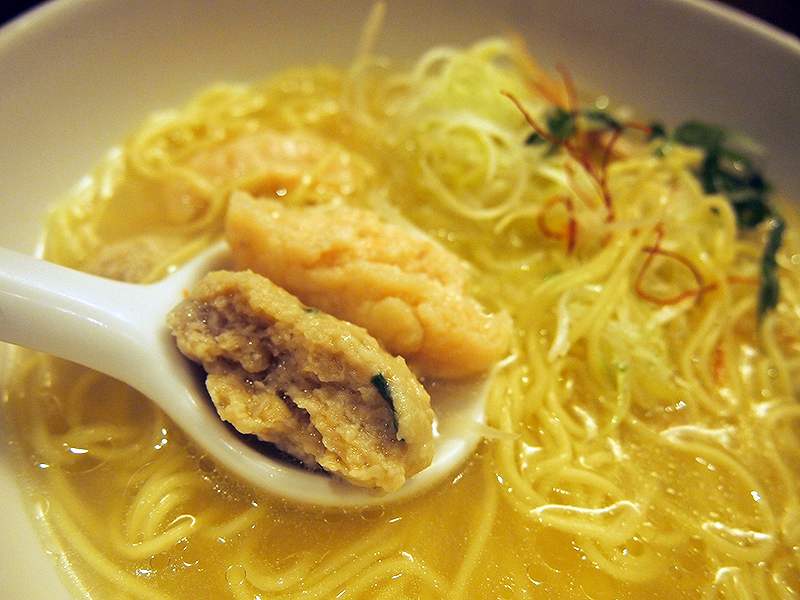
While eating, my thoughts kept returning to the soup. I wanted to keep drinking it; it’s not too salty or too thin. I don’t usually eat a lot, so I had to praise myself for adding a yakionigiri to the ramen.
I slurped all the ramen and dipped the yakionigri in the broth. When I split the yakionigiri with my chopsticks, the heshiko filling came pouring out.
I broke the yakionigiri into small pieces and used a large spoon to help hold the rice and plenty of broth in my mouth at the same time. It tastes different from the noodles, and I’m glad I ordered the yakionigiri. I wanted to actually shout a thank-you to the owners for making the yakionigiri, maybe because I like grilled rice which surface became a bit hard. The unique chewy texture of the yakionigiri soaked in the broth and the fragrant aroma is indescribable. The saltiness of the heshiko only served as another accent to the soup, and the synergistic effect of it all filled my mouth with flavor.
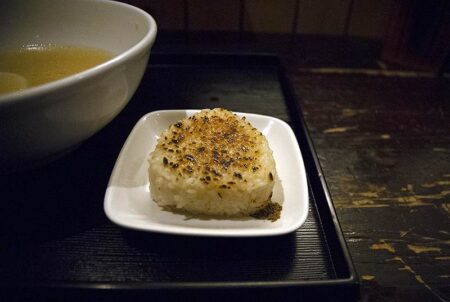
A heshiko yakionigiri (grilled rice ball)
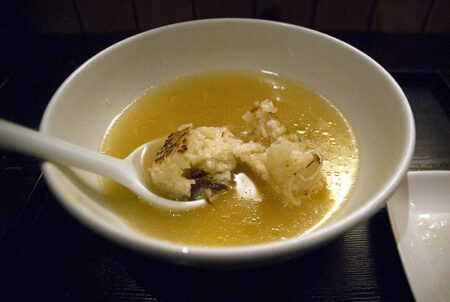
The filling of heshiko pours out
I was so full I couldn’t finish all the broth. I tried to scoop up the grains of rice with a spoon, but it was difficult eating all the grains of rice without eating the broth as well. I gave up and looked around the store, stumbling across a sign noting the shop offers yuzukosho condiment paste for free. You can put the condiment on your ramen when you want it to be a bit spicier. I was so absorbed in eating the ramen that I hadn’t noticed the sign. I felt resentment toward myself for trying so hard to eat and not noticing it before. I resolved I had to come back to the ramen shop sometime and try it then.
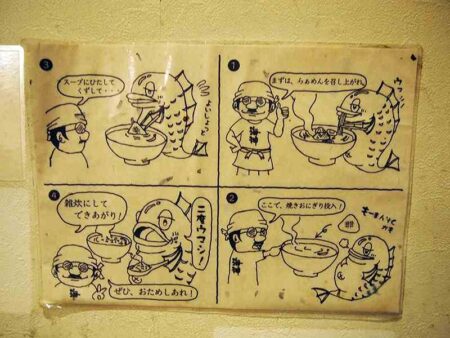
A four-paneled comic describes how to eat the heshiko yakionigiri grilled rice ball with ramen.
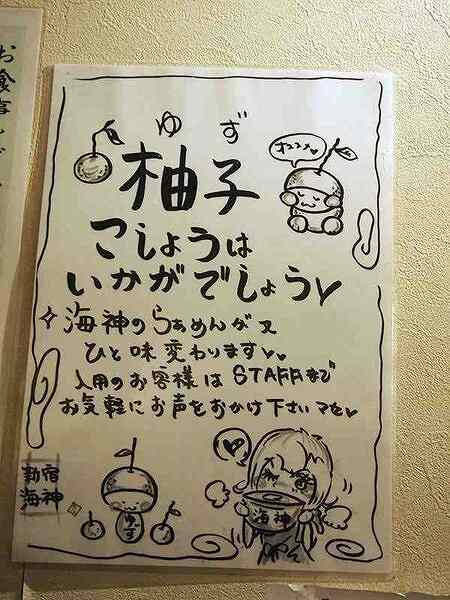
The sign says yuzukosho paste is available whenever you want it.
Ramen filled with the blessings of the sea
Etsuko Endo, the founder of the ramen restaurant, wanted to compete using only fish, so she named her shop after the sea god.
It was founded 13 years ago at a time when ramen with fish was rare. She had problems stocking up on fish bony parts, she said, and she walked fish shops, department stores and Tsukiji to get them. Endo could procure some flesh from fish, but fish leftovers were rarely sold as they were not generally used in cooking. She worked hard every day, and less than one year later, the owner of a fresh fish store called Uoshige in Higashinakano, Tokyo, approached his friends and made it easier to get fish. Even now, when people are lining up to eat her ramen, Endo still buys from Uoshige.
The main fish used in the broth are red sea bream and conger eel. After a lot of experimentation, she ended up using both in the broth, and the restaurant uses them in their broth every day. Beyond these two types, the stock changes from day to day. It also contains small fish that are not for sale, so the taste of the broth is different every day, and the differentiation in the soup’s flavoring serves as the drawing point of the shop.
In the morning, staff start to cook the bony parts of the fish they bought, plenty of broth, ginger and green onions. The soup stock begins being cooked in the morning to be served as the broth for dinner guests, according to Endo.
Meatballs for toppings are also made all day long. They prepare the chicken meatballs by removing small bones and then put them in a food processor until the texture softens.
Even though Endo originally planned to become well-known for ramen dishes that only use fish, she now also serves ramen with chcken meat balls because of a request from a customer who also wanted to eat meat. After another customer recommended using heshiko, she began making heshiko yakionigiri. Endo took the opinions and suggestions of her customers to heart and her restaurant’s menu has evolved as a result.
Heshiko is one of Fukui Prefecture’s traditional foods. Endo, who was already a fan of local delicacies, liked heshiko and immediately introduced it to the menu as she thought it would go well with the restaurant’s broth. Since it is difficult to buy only a small portions of heshiko in Tokyo, many customers visit Kaijin just to eat some. At the shop, you can eat a heshiko onigiri rice ball or heshiko Ochazuke, which is heshiko yakionigiri soaked with the broth served with the salt ramen.
“My restaurant’s main draw is the broth in spite of it being a ramen shop,” Endo said during a phone interview, laughing while she was at the Kichijoji branch of her ramen shop that day.
The ramen served is for the health-conscious, and many women visit the shop. Sometimes 90% of the customers are women some hours in the day, according to staff in the Shinjuku branch of Kaijin. There are also many guests from Islamic countries. The coronavirus pandemic has reduced the number of visitors to 10% of what was seen before the state of emergency was declared.
In the future, they plan to expand their range of delivery services.
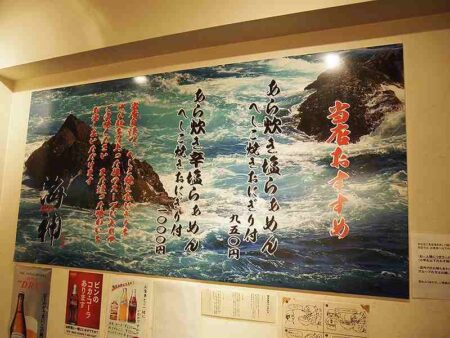
The sea is painted on the wall in the shop
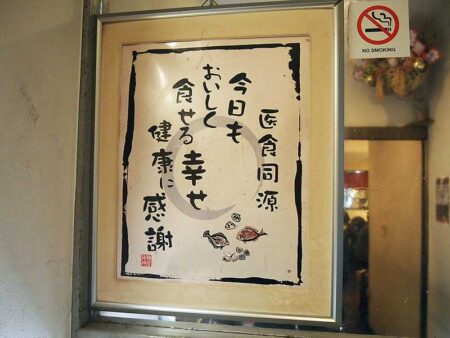
The drawing says “I am grateful for happiness and health that enables me to enjoy such a delicious meal.”
The Kichioji branch of Kaijin buys fish bony parts from the same place as the main store in Shinjuku, but the stocks are split between the two stores so the taste between them may be different even on the same day. The Kichijoji store also serves shellfish ramen, such as clam ramen and asari clam ramen, which the Shinjuku main store does not serve due to the size of their kitchen.
“Between you and me” said Endo with another laugh, “we use clams that cost more than ¥5,000 when ordered at a high-class restaurant in Ginza. It’s too expensive, but I want to deliver something delicious to my customers.”
After the interview, just as I walked out of the restaurant and on the way to the stairs, I found a picture on a wall saying, “I am grateful for happiness and health that enables me to enjoy such a delicious meal.”
I am glad I could eat such delicious ramen, but I definitely have to try that clam ramen at the Kichijoji shop and meet Endo in person. When I do visit that shop, I vowed I would not forget the yuzukosho paste.
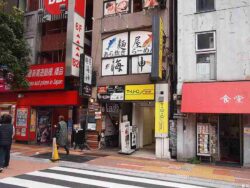
Kaijin
3-35-7 Shinjuku, Shinjuku Ward, Tokyo.
Lunch is served from 11:00 a.m. to 3 p.m. Dinner is served from 4:30 p.m. to 10 p.m. On Sundays or the last day of consecutive holidays, Kaijin is open from 11:00 a.m.to 10:00 p.m. Open every day.
A serving of salt ramen is ¥800 while a serving of the spicy salt ramen is ¥850. You can add a heshiko yakionigiri to your order for an extra ¥150. (All prices are excluding tax.) The chicken meatballs can be substituted for shrimp ones upon request.

Miho Nakamura, Japan News Staff Writer
As a working mother of two young sons, I haven’t been able to enjoy many of the spicy dishes I love because my taste buds have adapted to their level. For me, adding a seasoned egg is a must! I also tend to let any hot food or drink I have cool before I dig in because my tongue is a bit sensitive.

"JN Specialities" POPULAR ARTICLE
-

The Japan News / Weekly Edition (12/12-12/18)
-

Noodle Dining Shunsai / Rich Oyster Ramen to Savor at Odasaga; Experienced 68-year-old Owner Creates Numerous Ramen Varieties
-

The Japan News / Weekly Edition (12/5-12/11)
-

People Keep Loved Ones’ Ashes Close in Special Jewelry, Small Urns as Unique Way to Memorialize Them
-

The Japan News / Weekly Edition (12/19-12/25)
JN ACCESS RANKING
-

Tokyo Economic Security Forum to Hold Inaugural Meeting Amid Tense Global Environment
-

Keidanren Chairman Yoshinobu Tsutsui Visits Kashiwazaki-Kariwa Nuclear Power Plant; Inspects New Emergency Safety System
-

Imports of Rare Earths from China Facing Delays, May Be Caused by Deterioration of Japan-China Relations
-

University of Tokyo Professor Discusses Japanese Economic Security in Interview Ahead of Forum
-

Japan Pulls out of Vietnam Nuclear Project, Complicating Hanoi’s Power Plans



